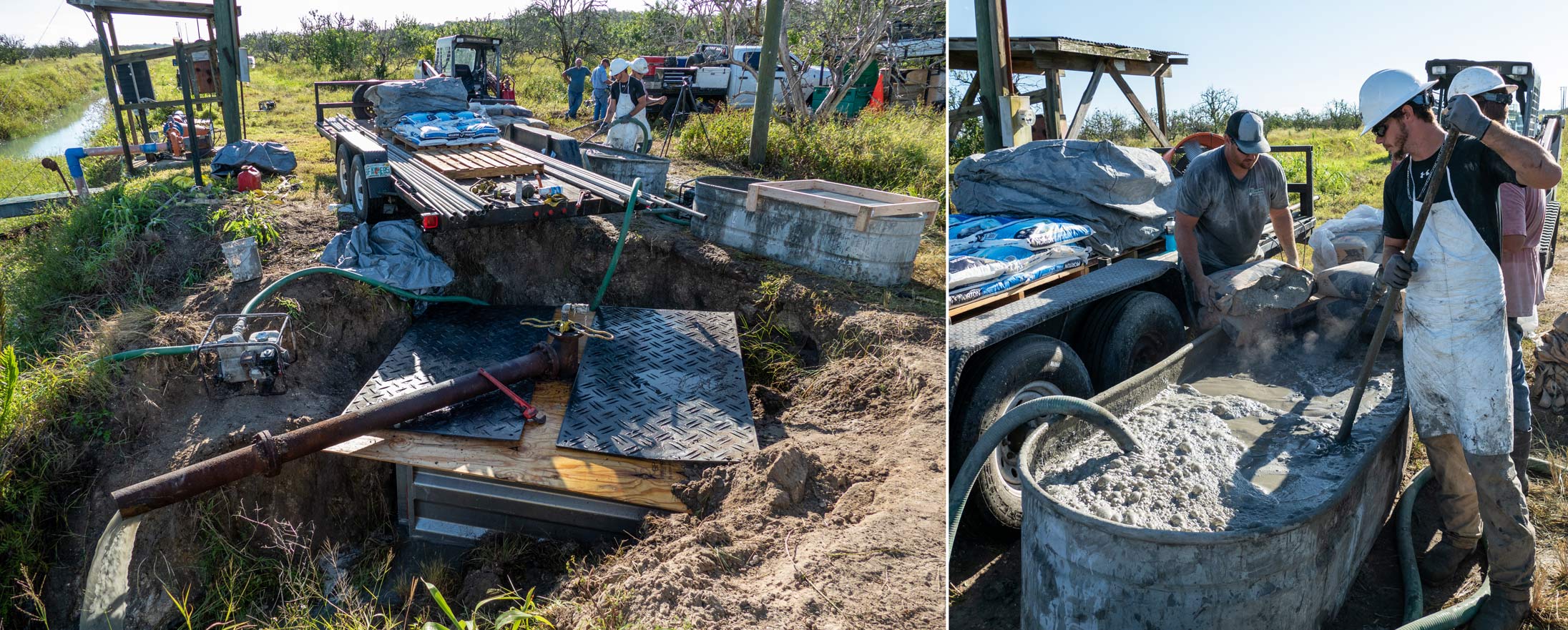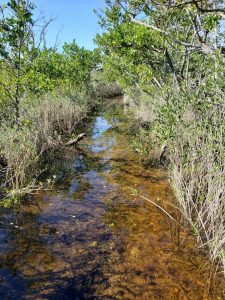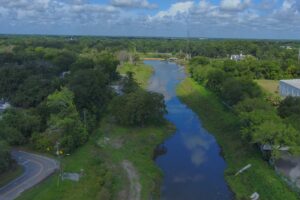District’s well plugging program saving billions of gallons of water
More than five miles from the nearest public road, deep in the hinterlands of a vast orange grove in Indian River County, an artesian well gushes water like a fountain at the Bellagio Hotel in Las Vegas.
Gary Foster, a hydrologist who leads the St. Johns River Water Management District’s artesian well plugging program, has seen his share of free-flowing wells, but this one is impressive. Several surging fantails of water spray from a rusty pipe jutting from the ground. The force of the water has eroded the surrounding earth, creating a submerged depression akin to a spring boil.
“That’s one hundred percent potable water flowing into that old canal day and night,” Foster says. “This well loses about 700,000 gallons a day and if left unchecked, in one year’s time would waste more than 255 million gallons. Our job is to put an end to the waste.”
Water conservation is a high-profile subject in a state boasting more than 21 million people at last count. And while irrigation ordinances and water-saving appliances are generally mainstream responses to water savings, the abundance of free-flowing wells is generally a lesser-known problem.
At this well site, Foster lays out a strategy with Ben Huss Jr., a third-generation well driller who is anxious to stem the flow. Huss estimates that there are hundreds of derelict wells throughout the district’s 18 counties that have been flowing unimpeded for years. Sometimes, it’s just a matter of finding them.
“Potable water is a valuable resource and people don’t realize it,” Huss says. “I’d rather be out of business and have all these wells capped. I lay awake at night thinking about the waste.”
Since the 1980s, the district has plugged more than 2,000 wells, resulting in a total maximum potential flow conserved of 727 million gallons of water a day. The program has taken on different forms over the years. In some cases, the property owner and the district shared costs; other times the district funded the entire plugging of the well.
Recently, the program has expanded to become a cost-share program in Indian River, Seminole and Brevard counties where the majority of abandoned wells are discovered. This is good news for property owners who have avoided shutting down their free-flowing wells due to the associated costs.
“A cost-share program allows the property owner to access our agreement with his or her participating county,” Foster says. “This gives property owners access to the available funding that they would otherwise not have been able to attain. Instead of shelling out thousands of dollars to plug a well, it can be done virtually free of charge to the landowner.”
The cost-share program was nothing short of a miracle for Ali Jaafar, a landowner in Oviedo’s Black Hammock area whose 55 acres of agricultural land held seven free-flowing wells ranging from tiny two-inch pipes to one that was eight inches in diameter.
“One of the wells on this site is losing approximately 1,000 gallons a minute,” says Foster, while checking out another well on the property that resembles a natural spring, complete with a sand boil. This well required 28.5 cubic yards of cement to plug. Imagine the costs to the property owner if this cooperative program wasn’t available.
Jaafar lauds the program.
“Gary Foster is on top of things,” Jaafar says. “I recommend to anyone who has a free-flowing well to contact Foster to solve the issue. He has a hard-working crew and they get the job done.”
Jaafar’s dilemma is not uncommon throughout the district. Agriculture is a staple in many regions, and tens of thousands of artesian wells are the lifeblood of row crop, cattle and citrus growers. An artesian well (also known as a free-flowing well) is a well that has been drilled into an aquifer in a location where the underground water pressure is great enough for the water to rise inside the well. Wells can be a cheap source of water because the pressure can sometimes be strong enough to send the water to the surface without the aid of a pump.

Well contractors work with district staff to plug an abandoned free-flowing well. Workmen mix a cement slurry that is used to plug an abandoned well.
Times changes. Land uses change. Wells’ metal casings deteriorate over time. Sometimes they’re simply found to be improperly constructed. Regardless of the scenario, free-flowing wells can adversely impact the quantity and quality of water in Florida’s underground water supplies (known as aquifers) or nearby surface water bodies.
“Our goal is to assist well owners in complying with Florida law that requires well owners to control discharges by properly capping or plugging wells and limiting flows to the amount needed for an intended use,” says Gary Foster. “We encourage public participation in identifying problems and actively work with other agencies, local governments and the public to detect, evaluate and control artesian wells.”
District Executive Director Dr. Ann Shortelle lauds well plugging as an action to protect Florida’s most precious resource that has no drawbacks.
“Our program has an immediate and direct impact on our water resources,” Shortelle explains. “The prevention of waste is obvious. Proper well plugging can prevent contaminants from entering our water supply. A deteriorating well casing can allow poor quality water to move upward into the fresher zones we use for drinking water.”
Costs to abandon a well can vary depending on the size and depth of the well and the plugging method required, but the average cost is approximately $6,000. The process of abandoning a well involves a site visit and well inventory, correspondence with the landowner and governments to formalize participation, temporarily capping the well, geophysical logging of the well and permanent well abandonment by a licensed well contractor.
Abandoned wells are plugged by pumping a cement grout through a PVC tremie pipe or drill rod, which is lowered to the bottom of a well. The cement is pumped from the bottom until it reaches land surface.
For additional information on the program, cost-share for abandoning a well, or to notify the district of a free-flowing well, please call 386-329-4570.







